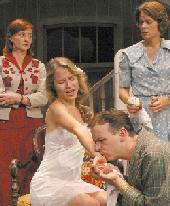SITE GUIDE
REVIEWS
FEATURES
NEWS
Etcetera and
Short Term Listings
LISTINGS
Broadway
Off-Broadway
NYC Restaurants
BOOKS and CDs
OTHER PLACES
Berkshires
London
California
DC
Philadelphia
Elsewhere
QUOTES
On TKTS
PLAYWRIGHTS' ALBUMS
LETTERS TO EDITOR
FILM
LINKS
MISCELLANEOUS
Free Updates
Masthead
Writing for Us
A CurtainUp Los Angeles Review
Toys in the Attic

Bonita Friedericy, Jane Longenecker, Donald Sage
(Photo: Michael Lamont) |
As The Little Foxes was based on Hellman's mother's family, Toys is based on her father and his two adoring sisters. The year is 1957. Julian Berniers brings his 21-year-old bride Lily and a mysterious fortune home to his sisters in New Orleans. The sisters, who always told him he would be a successful man some day, find themselves appalled by what success actually means. They sit there, dripping with furs and evening gowns designed for women half their age, gaping at steamship tickets that will take them on their fantasy trip to Europe -- without Julian. The older sister, Anna, accepts this but the younger one, Carrie, can not. Anna thinks of Julian as a son but Carrie's obsessive love for her brother is rife with an eroticism that neither will face. Even when Anna confronts Carrie with the truth, it doesn't stop her from seeking Julian's downfall to keep him by her side.
The catalyst is his childlike bride Lily, whose insecurity and jealousy are easy to trigger into betrayal. For Lily grown, see the character of Birdie in The Little Foxes, also based on Hellman's mother, but for the emotional validity of that desperate jealousy, see Hellman's own helpless immersion in her affair with Dashiell Hammett. When she heard he was sleeping with another woman, she once took a plane from New York to Los Angeles, broke into his house, trashed his bar and jumped back on the next plane to New York.
Lily's mother, Albertine Prine, an aloof aristocrat who disdains not only her daughter but people in general, is more world-weary than Regina in The Little Foxes but they are both aspects of Hellman's maternal grandmother The long intitial scene between the two sisters, which could be slow, is given perfect pacing by director Jessica Kubzansky who brings out the humor in Hellman's tart dialogue. Although the sisters may be bored at heart, in this production they animate every aspect of their trivial days.
Bonita Friedericy is particularly impressive as Carrie, ranging from playful humor to erotic passion to the sly maneuvering of an abandoned cat. The implacability in her final speech reveals beneath the facade of love an utter imperviousness to any needs but her own.
Donald Sage Mackay finds Julian's easygoing playful charm and Caryn West gives Anna a beautifully understated maternal quality. One of Hellman's most interesting characters, Lily, as written, could be hovering on the brink of derangement. She asks her mother with childlike vulnerability, Is there something the matter with me? Jane Longenecker succeeds brilliantly in making Lily real, playing the sensuous quality that captured Julian, and interpreting her mysticism as a perfectly believable element of a young girl. Nancy Linehan Charles not only brings out the dry humor in Lily's mother, Albertine Price, but displays the delicate balance of a woman who likes men. As opposed to the repression and obsession of the other female characters, it's an indispensable element and no one has caught it better than Charles. Alex Morris projects dignity and wisdom as Henry, her Negro employee and lover.
Excellent production elements include careful costume design by Alexa Stone. Some vintage costumes were borrowed from Warner Brothers. Jeremy Pivnick's mellow dappled lighting design catches the quality of a New Orleans summer and the aging house with its aging sisters. Tom Buderwitz's set design is a metaphor in itself, with lush plants and foliage pressing in on the drab neat house. Douglas Noe's hair and make-up, particularly the grisly job on Julian in the last act, are notable.
Despite such dramatic contrivances as having Carrie overhear a pivotal conversation, Hellman's play is timeless in its depiction of love and money, what Freud called the two pillars of life. Her unsentimental dialogue and tart humor are the welcome tools with which she carves.
|
TOYS IN THE ATTIC Playwright: Lillian Hellman Director: Jessica Kubzansky Cast: Caryn West (Anna), Bonita Friedericy (Carrie), Curtis C (Gus), Nancy Linehan Charles (Albertine), Alex Morris (Henry), Donald Sage Mackay (Julian), Jane Longenecker (Lily), Brad Bilanin (Taxi Driver/Moving Man) Set Design: Tom Buderwitz Lighting Design: Jeremy Pivnick Costume Design: Alexa Stone Hair & Makeup: Douglas Noe Composition & Sound Design: Steve Goodie Running Time: Two hours, 45 minutes with two intermissions Running Dates: August 16-September 14, 2003 Where: The Colony Theatre, 555 North Third Street, Burbank, Phone: (818) 558-7000 Reviewed by Laura Hitchcock on.August 16. |

At This Theater

Leonard Maltin's 2003 Movie and Video Guide

Ridiculous!The Theatrical Life & Times of Charles Ludlam

Somewhere For Me, a Biography of Richard Rodgers

The New York Times Book of Broadway: On the Aisle for the Unforgettable Plays of the Last Century

6, 500 Comparative Phrases including 800 Shakespearean Metaphors by CurtainUp's editor.
Click image to buy.
Go here for details and larger image.



